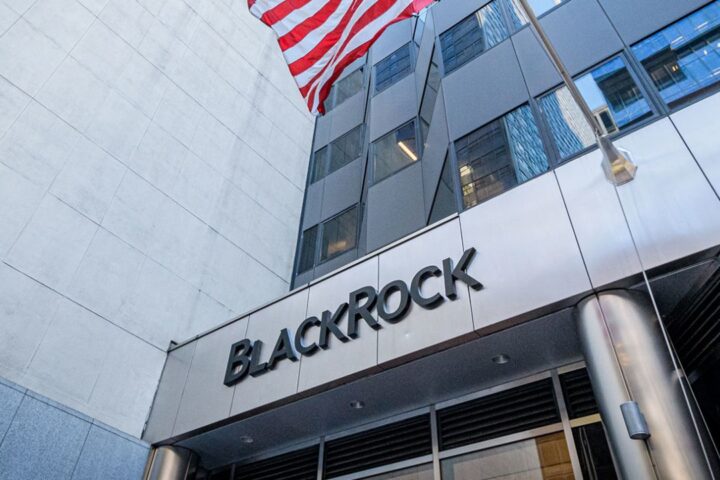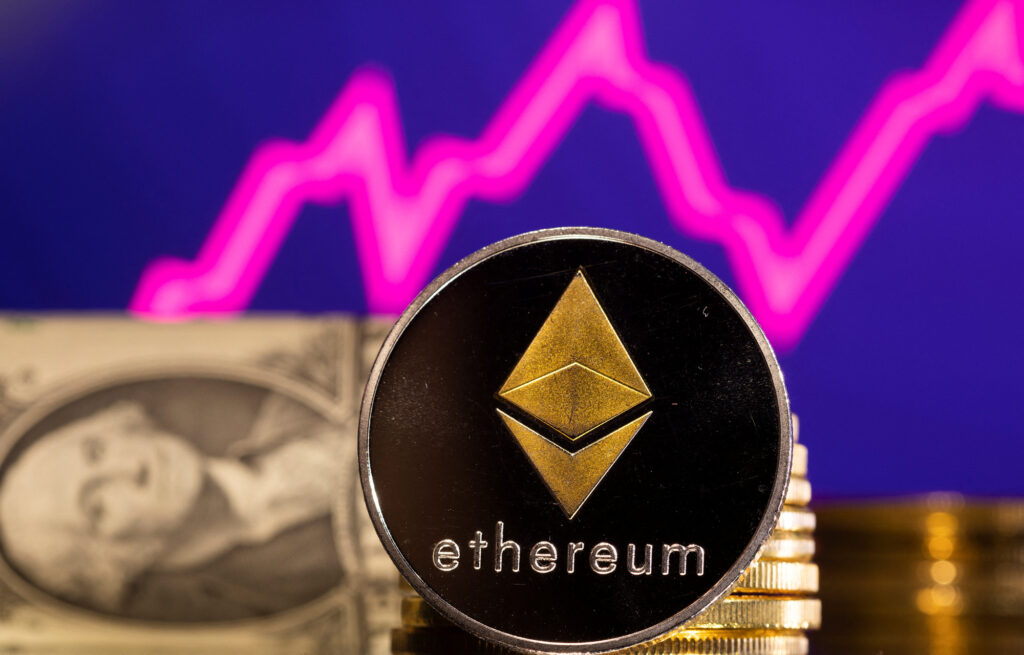Ether climbed to its highest level in nearly four years on Friday, briefly touching $4,729 and setting off $351 million in liquidations for traders betting against the cryptocurrency.
The move higher followed remarks from U.S. Federal Reserve Chair Jerome Powell, which fueled investor expectations of a more accommodative monetary policy environment.
The rally has intensified speculation over whether ETH could soon cross the $5,000 threshold for the first time.
Broader Market Signals Boost Momentum
The surge in Ether coincided with gains across risk assets, including a 1.8% rise in the tech-heavy Nasdaq Index.
This rebound reflects investors shifting away from bonds and other safe-haven positions as expectations of lower interest rates grow.
Over the past month, ETH has surged 33%, fueled by optimism around both macroeconomic conditions and Ethereum’s strengthening fundamentals.
Powell’s comments at the Jackson Hole Economic Symposium were a key catalyst: “The baseline outlook and the shifting balance of risks may warrant adjusting our policy stance.”
Bond markets are now pricing in a 45% probability that rates will fall to 3.5% or lower by March 2026, up from 37% the week prior, according to the CME FedWatch tool.
On-Chain Activity Shows Strong Uptick
Ethereum’s network activity has accelerated alongside the price rally.
In the last 30 days, transactions have risen by 63% and active addresses by 26%.
By contrast, Solana recorded only a 2% increase in transactions, with active addresses falling 14%.
BNB Chain experienced a sharper decline, with transactions down by half during the same period, according to Nansen data.
This divergence underscores Ethereum’s growing dominance among major smart contract platforms.
Futures Market Reflects Growing Confidence
Despite volatility, ETH futures markets suggest traders remain confident.
Futures contracts are currently trading at a 7% premium compared to spot prices, up from just 4% earlier in the week.
This indicates rising conviction among buyers even as some traders remain cautious, noting that Ether has yet to reclaim its 2021 all-time high of $4,868, unlike BNB and Tron, which now trade above their previous peaks.
Analytics firm CryptoQuant has observed a notable increase in aggressive buying behavior in ETH futures, with demand for leveraged exposure holding strong.
Aggregate open interest remains steady at 14.4 million ETH, equivalent to roughly $69 billion in dollar terms.
Path Toward $5,000
The convergence of higher futures premiums, resilient leveraged positioning, and surging on-chain activity all point to further upside potential for Ether.
While traders remain alert to resistance near all-time highs, sentiment suggests that a breakthrough to $5,000 could be imminent.
Whether Ethereum sustains such levels will depend on both macroeconomic shifts and the continued growth of its ecosystem.
For now, investors are watching closely as ETH inches toward a historic milestone.
President Donald Trump’s tariff strategy is creating turbulence across global supply chains — and at the same time, some of his administration officials are profiting from industries directly impacted by those very policies.
Recent disclosures show that top members of Trump’s team, including Commerce Secretary Howard Lutnick, have financial ties to Bitcoin and technology firms affected by tariff shifts.
Tariff delays and new measures
On Tuesday, the administration extended tariff relief on certain Chinese imports but confirmed new levies on over 400 products.
The list spans wind turbines, motorcycles, construction machinery, railcars and more.
While the tariffs are projected to generate billions in revenue, trade groups argue the measures are slowing growth and disrupting operations.
The National Foreign Trade Council (NFTC) warned the policies are “delaying growth, disrupting operations, and raising legal concerns among companies.”
Lutnick’s firm invests in Bitcoin
Filings with the Securities and Exchange Commission show Lutnick, via Cantor Fitzgerald, has been making significant investments in sectors exposed to Trump’s economic agenda.
On July 8, Lutnick received a federal waiver allowing him to engage in matters that could directly affect Cantor Fitzgerald.
That waiver has drawn scrutiny from watchdogs.
The firm has invested more than $120 million in Fidelity’s Wise Origin Bitcoin Fund and nearly $117 million in trading platform Robinhood, according to Quiver Quantitative.
It also holds stakes in Tesla, AMD and Alibaba.
Critics argue these holdings create a clear conflict of interest, given Lutnick’s influence over trade and commerce policy.
Bartlett Naylor of Public Citizen said: “When the Oxford English Dictionary next updates its conflict-of-interest definition, it’ll use Cantor Fitzgerald’s crypto ventures and the Lutnick connection as prime example.”
Other officials under scrutiny
David Sacks, Trump’s AI and crypto adviser, sold roughly $200 million in digital assets early in Trump’s second term to avoid conflict claims.
However, Sacks later received a similar waiver, allowing him to retain ties to firms seeking federal contracts.
In July, AI firm Vultron announced $22 million in funding from Sacks’ venture firm, Craft Ventures, noting its alignment with the administration’s AI strategy.
Trump has made AI development a national priority, unveiling an action plan in July that included support for semiconductor production.
Trade impacts on the economy
While Treasury Secretary Scott Bessent has described the tariff policy as “working pretty well,” industry voices remain skeptical.
The NFTC said the levies are raising raw material costs and threatening innovation in advanced manufacturing.
A Yale University Budget Lab study estimated that the tariffs will increase household costs by an average of $2,400 in 2025.
Everyday items are also being hit.
Wholesale vegetable prices were nearly 39% higher in July than a year earlier, while retailers like Home Depot report delayed home renovation projects due to tariff-driven material costs.
Despite the administration’s optimism, analysts say the long-term effects of the tariffs remain uncertain.
For now, one thing is clear: while businesses and consumers bear rising costs, some within Trump’s circle appear well-positioned to benefit.
Sportsbet.io, the world’s favourite crypto-led sports betting site, is celebrating the beginning of the 2025/26 football season with its most ambitious line-up of promos and games yet.
Taking centre stage are five 1M USDT jackpots, given away during the opening five gameweeks of the season, for anyone who can successfully answer 20 coin-flip questions.
Players can enjoy a brand-new game known as Pick’ems, which challenges them to make successful 50/50 predictions, with each correct choice increasing the prize.
There will also be major jackpots given for successfully predicting league positions in Europe’s big five: EPL, LALIGA, Bundesliga, Serie A and Ligue 1.
A spokesperson at Sportsbet.io said “We can’t wait for the start of the new football season, and we’ve been busy putting together Sportsbet.io’s biggest selection of promos to date. Our focus is on excitement and offering our loyal players the chance to win life-changing sums. Once again, Sportsbet.io is the place to be for fun, fast and fair betting.”
Among the other highlights to look out for this season is a new and improved version of the popular Pick4Win game, in which players need to answer four questions correctly about a sporting event for the chance to win a 50 USDT free bet.
There will also be a season-long Last Man Standing competition, with a 100,000 USDT prize pool, as well as blockbuster deposit bonuses and the chance to 3x payouts on winning transfer market bets.
Sportsbet.io is also sponsoring some of the biggest names in sport, including LALIGA and Snooker’s Players Championship. Look out for more promotions as the season progresses.
About Sportsbet.io
Founded in 2016 as part of Yolo Group, Sportsbet.io is the leading crypto sportsbook. Sportsbet.io has redefined the online betting space by combining cutting-edge technology, with cryptocurrency expertise and a passion for offering its players with the ultimate fun, fast and fair gaming experience.
Official Regional Partner of LALIGA, Sportsbet.io provides an expansive range of betting action across all major sports and eSports, offering players more than 1M pre-match events per year and comprehensive in-play content.
As the first crypto sportsbook to introduce a cash out function, Sportsbet.io is recognised as a leader in both online sports betting and within the crypto community.
In December 2023, a lucky Sportsbet.io won the biggest ever online slots jackpot while playing on the site, turning a $50 spin into a prize of more than $42 million.
Sportsbet.io prides itself on its secure and trustworthy betting service, with withdrawal times of less than 90 seconds, among the fastest in the industry.
For more information about Sportsbet.io, please visit https://sportsbet.io.
Sportsbet.io has gone live with the revolutionary new fantasy sports contest Pick’ems, making it the first place in the world where you can play the game with crypto.
Developed by Hub88 in collaboration with Odds88, who will bring comprehensive, real-time odds and data to the aggregator’s robust and customisable framework, Pick’em88 is designed to appeal to seasoned bettors as well as first-time gamblers with a simple, low barrier to entry interface and play style.
Pick’ems allows users to build their own Pick’em line with just a few clicks. It’s easy to understand for beginners and one of the most fun ways to bet on sports. Each pick is a simple 50/50 choice, like whether Kylian Mbappé will have more or fewer than 3.5 shots on target, or if an Arsenal vs Manchester City match will feature over 2.5 goals.
The more picks the player makes, the bigger the potential win. In short, Pick’ems reinvents sports betting into a fun, fast and fair betting experience.
A Sportsbet.io spokesperson said: “Sportsbet.io is the first place in the world where you can play Pick’ems with crypto. This is all about simplicity, fun, and big potential wins. We wanted to create something that, like Sportsbet.io, is fast-paced, easy to understand and made for fans. This is crypto meeting sports in a completely new way. With the Premier League kicking off, there’s no better place to play.”
Pick’ems is now live on Sportsbet.io in time for the start of the new Premier League season.
Over the coming months, there will be opportunities to bet different sports on Pick’ems, including basketball, American football, baseball and ice hockey.
Lara Falzon, CEO, Hub88 said: “We’re thrilled to introduce Pick’em88 to the market — a product that perfectly blends Hub88’s adaptable platform with Odds88’s real-time odds and data expertise. This collaboration has allowed us to create an experience that’s both dynamic and accessible, offering seasoned bettors depth and insight while giving newcomers an intuitive, low-barrier way to engage with sports betting.
“We couldn’t be more excited that Sportsbet.io will be the first to bring Pick’em88 to players. Their innovative approach and passionate community make them the perfect launch partner, and we’re confident they’ll showcase the unique, accessible and engaging experience we’ve built with Odds88”
About Sportsbet.io
Founded in 2016 as part of Yolo Group, Sportsbet.io is the leading crypto sportsbook. Sportsbet.io has redefined the online betting space by combining cutting-edge technology, with cryptocurrency expertise and a passion for offering its players with the ultimate fun, fast and fair gaming experience.
Official Regional Partner of LALIGA, Sportsbet.io provides an expansive range of betting action across all major sports and eSports, offering players more than 1M pre-match events per year and comprehensive in-play content.
As the first crypto sportsbook to introduce a cash out function, Sportsbet.io is recognised as a leader in both online sports betting and within the crypto community.
In December 2023, a lucky Sportsbet.io won the biggest ever online slots jackpot while playing on the site, turning a $50 spin into a prize of more than $42 million.
Sportsbet.io prides itself on its secure and trustworthy betting service, with withdrawal times of less than 90 seconds, among the fastest in the industry.
For more information about Sportsbet.io, please visit sportsbet.io.
Google has emerged as the largest shareholder of Bitcoin miner TeraWulf after securing a 14% equity stake through an expanded financial arrangement tied to AI infrastructure provider Fluidstack.
The deal centers on a 10-year colocation lease agreement between TeraWulf and Fluidstack.
To support Fluidstack’s obligations, Google agreed to increase its backstop, a financial guarantee that ensures long-term lease commitments are met.
In return, Google received warrants to purchase over 73 million shares of TeraWulf.
The new holdings place the tech giant ahead of other shareholders.
TeraWulf Confirms $3.2 Billion Guarantee
During a shareholder call, TeraWulf revealed that Google’s backstop commitment now totals $3.2 billion.
Kerri Langlais, chief strategy officer of TeraWulf, explained that the agreement gives Google a meaningful equity position.
“Google’s new equity makes it TeraWulf’s largest shareholder, providing a powerful validation from one of the world’s leading technology companies,” she said.
Langlais emphasized that the arrangement reflects “the strength of our zero-carbon infrastructure and the scale of the opportunity ahead.”
Deal Supports Lake Mariner Data Center Expansion
As part of the agreement, Fluidstack exercised an option to expand operations at TeraWulf’s Lake Mariner campus in New York.
The expansion includes a new purpose-built data center expected to go live in the second half of 2026.
Langlais clarified that Google’s $3.2 billion guarantee applies strictly to Fluidstack’s lease commitments.
“This is not a guarantee of TeraWulf’s corporate debt, nor do we have access to those funds,” she said.
“The backstop is tied exclusively to contracted AI and high-powered computing lease revenues and is unrelated to our Bitcoin mining operations.”
Mining Operations Continue, But AI Takes Priority
The deal comes as many Bitcoin miners diversify into artificial intelligence and high-performance computing (HPC) services.
The April 2024 halving reduced block rewards to 3.125 Bitcoin, cutting into profits and encouraging miners to explore other revenue streams.
Langlais noted that while TeraWulf intends to maintain its mining platform, the company sees more potential in AI workloads.
“In the near term, mining generates cash flow and provides a valuable resource to the electrical grid,” she said.
However, she added that long-term growth lies in redirecting energy capacity toward AI and HPC contracts with partners such as Fluidstack and Google.
Market Outlook for AI Integration
Industry observers see the shift as transformative for miners.
VanEck estimated in 2024 that if mining firms redirected 20% of their energy to AI and HPC by 2027, they could collectively earn an additional $13.9 billion annually over 13 years.
TeraWulf projects its deal with Fluidstack alone could generate $6.7 billion in revenue, with potential to reach $16 billion through lease extensions.
These figures underscore why miners increasingly view AI as a growth driver.
TeraWulf Shares See Volatility
News of the Google-backed agreement boosted TeraWulf’s stock (WULF) in Monday’s trading session.
Shares rose 17% to $10.57 from a prior close of $8.97 before retreating later in the day.
By the end of the session, the stock settled at $9.38, with a further decline of 1.28% in after-hours trading.
Despite the pullback, the involvement of Google has given TeraWulf new visibility and reinforced its strategy of blending Bitcoin mining with AI infrastructure.
Bitcoin remains just below its all-time high of over $124,000, and institutional investors are closely watching its movements.
Strategy, the largest corporate holder of Bitcoin, has signaled plans to expand its holdings further even as the cryptocurrency consolidates.
Co-founder Michael Saylor recently indicated that more purchases are on the horizon.
The company already added 155 BTC on Monday for $18 million, lifting its total stash to 628,946 BTC worth more than $74.2 billion.
Strategy’s Investment Record
Strategy has become the go-to proxy for funds and retail investors who cannot or do not want to hold Bitcoin directly.
Its Bitcoin-first strategy has made the company one of the most prominent players in the digital asset space.
According to SaylorTracker, the firm is sitting on unrealized gains exceeding $28 billion, representing a return of more than 60% on its investment.
This strong performance underscores the success of its long-term accumulation model.
Accelerated Purchases Since 2024
Strategy’s Bitcoin buying spree accelerated after the U.S. presidential election in November 2024.
Since then, the firm has acquired 376,726 BTC in just nine months.
For perspective, it took more than four years to accumulate 252,220 BTC before this aggressive phase of buying began.
This shift shows how political and market conditions have influenced corporate treasury strategies.
Saylor’s Focus on Bitcoin
Despite the rise of companies adopting altcoin treasury strategies, Saylor remains firmly committed to Bitcoin.
“I still think the vast majority of the capital flowing into the space is flowing into Bitcoin,” he told Bloomberg in August.
“We’ve gone from about 60 companies capitalizing on Bitcoin to 160 companies just in the past six months; so, I’m laser-like focused on Bitcoin,” he added.
Saylor has repeatedly dismissed concerns about diversification, arguing that Bitcoin’s position as the dominant cryptocurrency gives it a unique moat.
Institutional Interest and Market Impact
Strategy’s accumulation strategy has positioned it as a cornerstone of Bitcoin’s corporate adoption.
Institutional funds unable to buy BTC directly often use Strategy shares as a proxy investment.
Retail investors also favor the stock as an alternative to self-custodying crypto.
The company’s commitment has sparked a wave of imitators, though none have matched its scale.
According to BitcoinTreasuries.NET, Strategy’s holdings surpass the combined total of the next 10 largest Bitcoin treasury firms.
This dominance has given the company significant influence in the sector.
Strategy’s Market Legacy
Since it began accumulating Bitcoin in 2020, Strategy’s share price has risen nearly 2,600%.
This growth has drawn a wide spectrum of investors, from institutional funds to everyday traders.
While Bitcoin’s future remains uncertain, Strategy’s conviction has created a template for how corporations can leverage digital assets.
With more purchases on the horizon, the company shows no signs of slowing down.
Venture capital firm Digital Currency Group (DCG) has launched fresh legal action against two of its subsidiaries, intensifying the ongoing fallout from the collapse of Three Arrows Capital (3AC).
In a filing to the US Bankruptcy Court for the Southern District of New York, DCG alleged that Genesis Global Capital and Genesis Asia Pacific profited unfairly from a $1.1 billion promissory note tied to the 2022 default of 3AC.
The complaint argues that instead of suffering losses, the Genesis entities received “hundreds of millions of dollars” in gains, creating an obligation to return overpayments to their parent company.
Background to the Promissory Note
DCG issued the 10-year note in June 2022 to cover a potential equity shortfall in Genesis Asia Pacific following 3AC’s failure to meet obligations.
At the time, concerns loomed that the collapse of 3AC — one of Genesis’ largest borrowers — would trigger significant liquidity issues.
However, according to DCG, cryptocurrency markets later rebounded, increasing the value of collateral held against the loans.
That included shares in Grayscale’s Bitcoin Trust, which surged alongside Bitcoin’s recovery.
DCG claimed Genesis not only avoided financial damage but ultimately profited from 3AC’s collapse.
“[T]he incremental amounts realized by Genesis after issuance of the Note were … far more than sufficient to overcome the prior $1.1 billion collateral shortfall — and, on information and belief, allowed Genesis to profit from [3AC]’s default by recovering nearly $2.8 billion on the original $2.36 billion in [3AC] Loans,” the filing said.
Genesis Pushes Back
Genesis, however, has rejected the latest complaint, accusing DCG of attempting to rewrite history.
“DCG’s unfounded, haphazard and convenient about-face to withhold 3AC distributions is meritless,” said Luke Barefoot, partner at Cleary Gottlieb and counsel to Genesis.
“It flatly contradicts the written agreements, DCG’s representations to the bankruptcy court, and the fact that DCG already handed over $100M+ in distributions.”
This legal clash follows earlier suits filed by Genesis against DCG, its affiliates, and CEO Barry Silbert.
In May, Genesis sought $3.3 billion in damages, accusing its parent company of fraudulent transfers and insider enrichment in the lead-up to bankruptcy.
The Wider Market Context
The 3AC default was one of several shocks that rattled crypto markets in 2022.
The collapse of the Terra ecosystem triggered a cascade of failures, leaving investors with heavy losses and exposing vulnerabilities across the industry.
That same year, FTX — once one of the largest exchanges — imploded in spectacular fashion, with executives later indicted for fraud.
DCG’s filing referenced the wider turmoil, noting that even without 3AC’s collapse, Genesis would have struggled to survive.
“Even had [3AC] not defaulted in June 2022, [Genesis Global Capital] would not have had sufficient capital to withstand the unexpected and devastating market rout that followed the collapse of FTX in November 2022,” the filing stated.
Genesis halted withdrawals that month before officially declaring bankruptcy on January 19, 2023.
Restructuring and Recovery
After months of proceedings, Genesis completed its restructuring in August 2024.
The plan involved distributing approximately $4 billion to creditors and other affected parties.
While this was seen as a significant step toward closing one of the darkest chapters in crypto lending, disputes between Genesis and DCG remain unresolved.
DCG is now seeking more than $105 million plus interest from its subsidiaries, arguing the terms of the promissory note require repayment given the profits made from 3AC’s collateral.
Ongoing Legal Battle
The latest filing highlights the complex financial web left by crypto’s 2022 crash, with companies still grappling over responsibility for billions lost and gained.
For DCG and Genesis, the courtroom has become the battleground for settling questions of accountability.
The outcome of this case could have major implications, not just for the firms involved but also for creditors seeking clarity on how recoveries from failed borrowers are handled.
With tensions high, the dispute underscores how the ripple effects of 3AC’s collapse and the wider market downturn continue to haunt the sector.
Coinbase has completed its acquisition of Deribit, the world’s largest crypto options trading platform by volume, marking another significant step in the company’s efforts to broaden its global presence.
The $2.9 billion deal, first announced in May, officially closed this week.
Deribit recorded over $1 trillion in trading volume in 2024, drawing a dedicated base of institutional and sophisticated traders.
Coinbase said the platform’s strong client loyalty and market leadership made it a strategic addition to its expanding suite of services.
Building a One-Stop Crypto Hub
Coinbase has been steadily growing its offerings to serve diverse segments within the crypto sector.
The exchange now provides a perpetual futures platform, prime brokerage services, retail spot trading, institutional lending, and secure asset custody.
By integrating Deribit’s operations, Coinbase aims to bolster its derivatives capabilities while reinforcing its ambition to become a one-stop destination for digital asset services.
Despite the milestone, Coinbase’s stock slipped by roughly 2.5% in intraday trading following the deal’s closure.
This minor dip follows a broader pattern of market adjustments after major acquisitions.
Six Acquisitions in 2025
The Deribit purchase is one of six acquisitions made by Coinbase so far in 2025.
In January, the exchange acquired Spindle, a blockchain-based advertising platform designed to help creators boost their visibility online.
The same month, Coinbase brought on the team behind Roam, a blockchain-based web browser project.
In July, it added Liquifi, a platform focused on supporting early-stage token startups with management tools and resources.
These deals reflect Coinbase’s strategy of expanding into complementary areas of blockchain and crypto infrastructure.
Industry-Wide Expansion Trends
Coinbase’s aggressive growth mirrors a wider trend among major crypto exchanges branching into adjacent markets.
Kraken, for instance, launched tokenized stock trading for non-US residents in May, tapping into the emerging tokenized securities space.
The company also offers crypto futures, staking, asset custody, and over-the-counter services for institutions.
Robinhood has been blurring the line between traditional and digital finance by providing mixed-asset trading and announcing a layer-2 blockchain for tokenized stock trading in Europe.
Meanwhile, Binance continues to diversify its portfolio with retail and institutional offerings, including options, futures, and token launch platforms.
Since 2018, Binance has been actively acquiring crypto wallets, blockchain development teams, exchanges, and analytics firms.
Coinbase’s move for Deribit underscores the competitive race among major exchanges to expand capabilities and secure market share in the evolving global crypto economy.
Standard Chartered has sharply increased its Ether price target for 2025 to $7,500, up from a previous $4,000, citing rising institutional demand and regulatory clarity on stablecoins.
The bank’s report highlighted that Ether ETFs and corporate treasuries have bought 3.8% of all ETH in circulation since early June.
This pace is nearly double Bitcoin’s fastest rate of institutional accumulation during the 2024 US election period.
Catalysts for Growth
The bank said two major developments have boosted sentiment: strong industry engagement from the Ethereum Foundation and Etherialize, and Ethereum co-founder Vitalik Buterin’s plans to increase layer-1 throughput tenfold.
This would allow more high-value transactions to settle on the main chain while smaller ones move to layer-2 networks such as Arbitrum and Base.
Another driver is the GENIUS Act, passed in July, which sets a legal framework for stablecoins.
Stablecoins now account for 40% of blockchain fees, with over half issued on Ethereum.
Standard Chartered expects the stablecoin market to grow from its current size to $2 trillion by 2028, significantly increasing Ethereum’s usage.
Market Outlook
The bank forecasts Ether will break its previous all-time high in Q3 2025 and outperform Bitcoin, with the ETH-BTC ratio rising from 0.036 to 0.05.
Its long-term projections put ETH at $12,000 in 2026, $18,000 in 2027, and $25,000 by 2028.
At present, ETH trades at $4,692 — just below its 2021 record of $4,891.
Short-Term Market Moves
With Ether close to its all-time high, some large holders are taking profits.
The “7 Siblings” Ethereum whale group recently sold $88.2 million worth of ETH, unloading 19,461 coins at an average of $4,532.
Despite this selling pressure, Standard Chartered expects long-term demand drivers to outweigh short-term volatility.
Ethereum’s recent rally has prompted a wave of profit-taking among short-term holders, as the cryptocurrency continues to hover around the $4,300 mark.
On-chain analytics firm Glassnode reported that traders holding Ether for less than 155 days have been cashing out at a faster pace than long-term investors.
The firm’s data shows that the seven-day simple moving average of realized profits is approximately $553 million per day, with the majority of those gains coming from short-term holders.
“Short-term investors are realizing far more gains, driving the current wave,” Glassnode noted in a post on X.
Long-Term Holders Remain Steady
While short-term traders appear eager to lock in profits, Glassnode found that long-term holders are taking gains at levels comparable to December 2024.
This suggests that seasoned investors are not rushing to exit their positions, despite the recent surge.
Profit realization across the market remains roughly 39% lower than the peak levels recorded last month, when Ether traded near $3,500.
Price Performance and Market Sentiment
Ether has gained 43% over the past month, currently trading around $4,283 according to Nansen.
However, it still sits about 12.7% below its all-time high of $4,828, reached in November 2021.
Some traders remain cautious about a near-term push toward those highs.
Data from CoinGlass indicates that approximately $2.23 billion in positions could face liquidation if the price approaches $4,700.
The hesitancy stems in part from earlier struggles this year, when Ether dipped below $2,000 in March and several rally attempts faltered before the latest climb.
High-Profile Moves and Key Levels
On Saturday, BitMEX co-founder Arthur Hayes revealed he had bought back into Ether, just a week after selling $10.5 million worth when the token traded at $3,507.
Since Sunday, Ether has crossed above $4,300 multiple times, only to fall back below.
This level has become a focal point for traders watching for signs of a sustained breakout.
Institutional Interest and FOMO Risks
Institutional activity in Ethereum has been growing, with companies holding a combined 3.04 million ETH in their treasuries — worth about $13 billion.
Still, some analysts warn that public announcements of large institutional purchases can spark short-term volatility.
Santiment analyst Brian Quinlivan said that such news “can trigger FOMO that may briefly stall or even push Ether’s price down.”
The coming weeks will reveal whether Ethereum can maintain momentum or if profit-taking pressure will drive a pullback.











